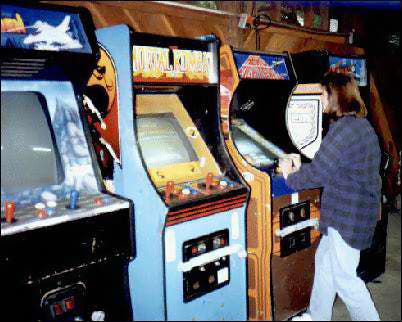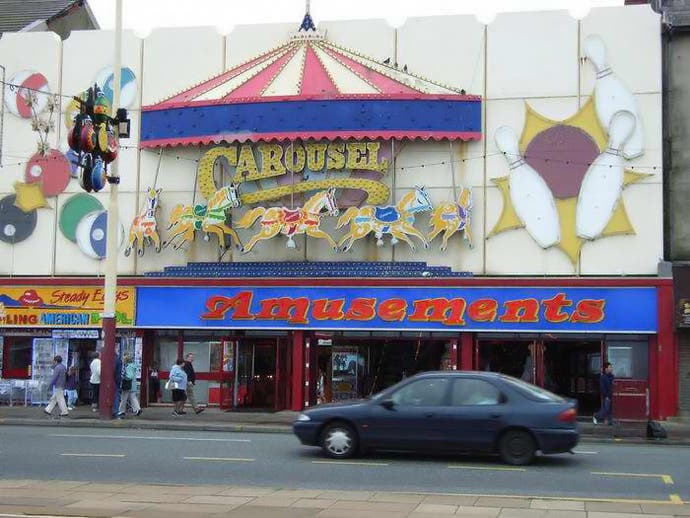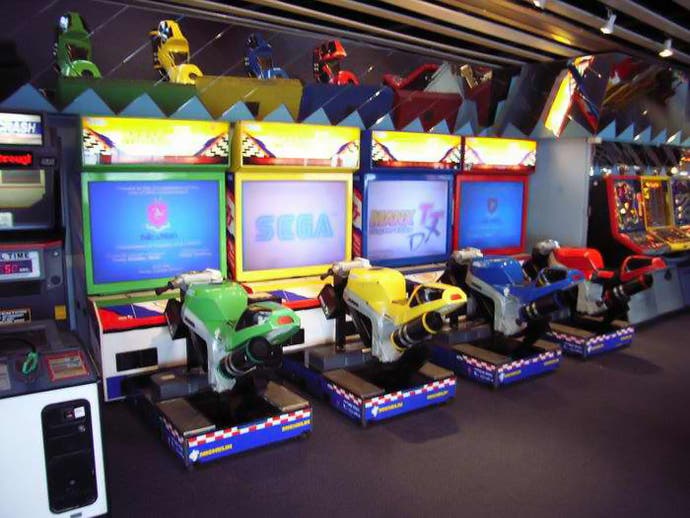The Coin-Op Generation
Saga of the seafront scene.
Although the word "arcade" carries strong connotations of videogame splendour, our generation has a very unique and, dare I say, limited opinion of what the amusements once were. Our time in them was fleeting but illustrious, and redefined coin-operated entertainment for ever.
Sea fronts were already host to tightly packed regiments of coin guzzling gaming establishments long before Space Invaders first landed on our planet. My own parents must still bite their tongue to stop themselves from referring to those thunderous temples of neon as "penny arcadáes". Bagatelle, pinball, fruit machines, one-armed bandits, donkey derby and a myriad of other mechanical marvels strained under the weight of yesteryear's loose change while videogames were still a glint in Ralph Baer's far-seeing eye.
And while the concept of family orientated micro-gambling had become a holiday institution, the arcades also housed a distinctly illicit feature that warranted an abundance of shadowy corners for a "gentlemanly" clientele. Naughty flip-book viewers provided a guilty pleasure that helped establish the crooked connotations that prompted more prudish holiday makers to cast a disdainful gaze on the shady amusement venues; an ill reputation that endures to this day.

The arcades went through 50 or more years of preparations waiting for the videogame to arrive: the change booths, dark corners, low ceilings and sea front venues already in place for the gaming phenomenon that was brewing in America.
Whether by chance or design, these games were being bred for our arcades. The first ever coin-op, Computer Space, was built to slot straight into gaming and gambling dens across the world. An angular, six foot tall mirror of the human form, Computer Space established the rough dimensions of the arcade cabinet, though it's similarity to many of the mechanical amusement machines which had been a repository for Blackpool's small coinage for many decades was no coincidence.
Nor was it by random chance that the Pong prototype was first tested in a bar. Coin-op games were a natural addition to the sordid, working-class drinking retreat; where the proletariat of the world found their hard earned - and much needed - escapism. Almost immediately, the makeshift coin mechanism of the Pong prototype (made from and old paint tin) sprang a fault; it overflowed with loose change and damaged the game's circuitry. In only two incarnations, separated by only one year, the videogame was primed to invade the arcades and change the way we avoided the rain of a British holiday.
Inevitably, this new trend found its way to our shores, and there it stopped - setting up outposts of cutting edge entertainment technology in the arcades of sea front retreats. But their arrival was sudden and unexpected, catching the donkey riders and sand castle architects somewhat unaware. We were used to Noughts ‘n' Crosses machines spilling 2p pieces all over the floor, and coin pushers which had seen so much action the veneer had worn away under the perpetual motion of the change shoving arms. But the real difference wasn't the style of gameplay - it was the reward.

Why would anyone play these games? You didn't win any money from them.
I saw people pouring their coins into these machines with gay abandon, always confused as to their motivation. Providing proper incentive was a simple matter for a fruit machine or one-armed bandit - you could reasonably expect to double your money about an eighth of the time (meaning on average you only lost four times what you put in), but a game without remuneration was a difficult thing to sell. Strolling past the harsh contrast of vivid raster up-lighting and impenetrable darkness of a Star Wars cockpit cabinet, I recall the exact moment when my financial question was answered.
Being the perfect age to worship all things from a galaxy far, far away, I had no option to quickly shed my principles and accept Vader's beckoning hand from the side of the machine. I simply couldn't allow myself to believe what I saw; the prospect for disappointment was too great. Were these people actually piloting an X-Wing Fighter through the trenches of the Death Star? The colour of my arcade money was distinctly copper, and this new machine called for a sacrifice of silver - no small decision for one so impecunious and unsure.
As well you've guessed, this began an immediate an undying passion for the changing face of arcades. The stagnant, metallic splash of a non-interactive coin pusher could never again slake my entertainment lust, and one-armed bandits lost their power to force the money from my pockets. Games seemed to materialise in front of me; my perception forever altered, finally capable of seeing the amazing, digital heroes squirreled away amongst the remnants of the old, mechanical amusement industry.
This era of discovery was an incredible time. Much of the thrill was found in scouring the arcades simply trying to hunt down favourite games, while discovering new ones with increasing regularity as the videogame industry exploded. My family was unable to comprehend what it was I suddenly felt the need to discover in already familiar arcades, and I had no answer. I was looking for games I didn't know.

As the 1980s began to grow old, a forced maturity was pushed onto the arcades as operators followed the glistening flow of coins away from fruit machines and toward videogames. More and more valuable space was awarded to game machines, while prime amusement real estate was set aside for impressive dedicated cabinets. In the space of a couple of seasons, the promenade at Blackpool was transformed from one of family entertainment into the shameless exploits of futuristic, raster-based warfare. Space Harrier's booming death knell could be heard from the North Pier to the Pleasure Beach, while dad's attempted to live out their unaffordable mid-life crisis by hunching themselves over a Hang-On machine, and girls dominated the high score tables of Pac-Man and Wonder Boy.
But the real flavour of our wondrously transformed arcades wasn't in mammoth, hydraulic cabinets. It was in old, battle damaged generic cabs, with cigarette burns and joysticks worn smooth. These were the machines that housed the gamer's games: Shinobi, Double Dragon, Strider, Phoenix, 1942, Final Fight. You never saw these awesome titles in a brand spanking new cab, and you didn't want to. The thought that on your next visit, that same machine, that knew your savage touch so intimately, might house the next amazing new game fresh from Japan was a thrill in itself, and brilliantly exemplified the reason for our arcade passion.
By this point, we were the elite - and I say that without ego or pretention. We were playing games at home, albeit severely watered down, long-lost cousins of the arcade pantheon. The home systems kept us entertained between woefully irregular trips to the sea front, but couldn't compare to the coin-op realm. Home systems were our videogame heroes brutally domesticated - subjugated, homogenised and battery packed into cages far too small. Visiting these powerful, wild animals in their natural habitat was the only way to appreciate their raw ability to thrill; evolving, cross-breeding and thriving under the fluorescent glow of neon as only an unrestrained viral plague knows how.

Videogame colonies soon spread inland, bringing only the raw, unadorned basics of their existence to the back alleys and dilapidated enclaves of Britain's town centres. In many ways, these sordid grief-holes epitomised the crude, fundamental purpose of coin-operated gaming. Cheap machines, re-homed and uncared-for, but packed with digital treasures for those brave enough to go exploring for them. No more the family holiday fun - this was the feeding of an entertainment addiction, a habit not easily sated with home gaming or sporadic trips to distant coastal towns. But we didn't care. How else could we witness the lustre of Operation Wolf, or be with our own kind for the co-operative violence of Double Dragon and Final Fight? This phase in the life of the arcade was one of refinement; whittled down to its primal purpose and laced with illicit distraction.
Despite the real essence of our coin-op scene being contained in the war-horse JAMMA cabs at the back of the arcade, the hulking, proprietary monsters placed in the yawning doorways of the promenades - intended to entice the uneducated and unsure into the amusements - began to take over. Unfortunately, this form of life was too big to support itself, and as quickly as they seemed to arrive, our vision of the arcades was gone. Grabbing machines filled with this year's knock-off Disney merchandise leapt into the void, and affordable, high-tech gaming was retired to the home console arena.
It's hard to believe that only one generation (two, at a stretch) ever really saw the arcades at their peak. We hear hushed, background talk of ROMs and license rights for the disembodied spirits of 20-year old games as arcade creepers attempt to revisit their wonderful game playing youth through MAME. But regardless of legality and tedious arguments of ownership, these thousands of incredible coin-op titles are a legacy given to us by game design gods no longer worshipped, and though their reign was brief, it's important that their worshippers not forget the world they created or the champions that populated it.






.png?width=291&height=164&fit=crop&quality=80&format=jpg&auto=webp)
